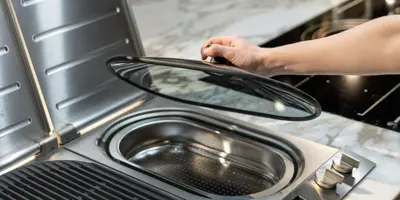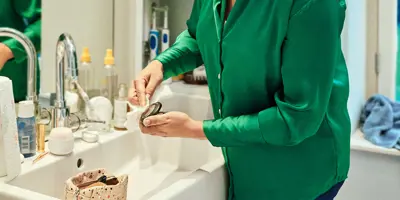139 people found this helpful

The kettle is one of the most essential kitchen appliances, helping make everything from rice, to gravy, to the mighty cup of tea. However, kettles take a lot of punishment, and despite how essential they are, kettle cleaning never seems to be high on anyone’s priority list! If you live in an area with hard water, you’ll know just how quickly limescale can build up. One minute everything is fine, and the next you’re drinking your morning coffee, wondering how it’s both slimy and flaky at the same time.
But not to worry! Removing limescale from your kettle doesn’t have to be difficult, and we have put together this guide on how to descale kettles, so you can make sure yours gets all the TLC it needs. After all, your kettle is always there when you need it, so keeping it in good shape is really the least you could do.
Why do kettles get limescale?
Wondering why cleaning your kettle is so important? Apart from the obvious (we’re thinking about that slimy coffee again), limescale build up can actually clog the heating element in your kettle. This makes it worse at heating water.
Limescale can also leave a grubby residue on the outside of your kettle. Remove limescale inside and out to get your kettle bright and shiny on the outside and working at its best on the inside.
How do I descale a kettle?
Wondering why cleaning your kettle is so important? Apart from the obvious (we’re thinking about that slimy coffee again), limescale build up can actually clog the heating element in your kettle.
This happens because minerals in the water (such as calcium) form calcium carbonate while boiling. Hard water has more of these minerals, which means places with hard water tend to get more limescale build up on appliances.
Limescale can make kettles less efficient, and kettles are already notoriously energy thirsty. Keeping your kettle clean can help with this and saves on boiling time too, so you can get that much-needed cuppa even quicker!
Limescale can also leave a grubby residue on the outside of your kettle and block up the spout, which can cause flakes of limescale to end up in your beverage! Removing limescale from both inside and outside your kettle is key to getting the best out of it.
How do you descale a kettle?
If you’re reading this guide, you might have already worked out that limescale is hard to scrub off surfaces manually. Plus, scrubbing your kettle too hard can damage its surface and even break it completely.
Altogether, removing limescale naturally is both better for your kettle and much easier for you! One of the best ways to descale a kettle is to use an acid to weaken the limescale. Ingredients like lemon juice and vinegar are simple home remedies for limescale removal which are perfect for the job.
How to descale a kettle with vinegar:
Vinegar is a great gentle acid for all sorts of home cleaning. Use it to get limescale off the kettle with minimal effort.
- Make sure your kettle is unplugged.
- Fill the kettle ¾ full of equal parts white vinegar and water.
- Close the lid and bring to the boil.
- Rinse a few times to clear out the dislodged limescale and admire your new limescale-free kettle!
- The next step is technically optional but very highly recommended before you start brewing: boil your kettle again using only water and rinse again to remove the smell and taste of vinegar (unless you fancy vinegar-infused tea!)
If you have a lot of build-up then you may find that removing limescale from some areas requires a more targeted, intense approach. Soak a sturdy kitchen towel with vinegar and wrap it around any areas with a lot of limescale. Leave for at least an hour, and you should then be able to descale the kettle by simply wiping the limescale off.
Not a fan of vinegar? You can also remove limescale with citric acid. Just fill your kettle with plain water, add half a lemon, and boil it a few times. This should descale the kettle and leave it smelling of fresh lemon! Again, you might want to rinse and boil with clean water a couple of times before your next use.
How to descale a kettle with bicarbonate of soda
Another easy way to remove limescale from a kettle is using bicarbonate of soda. Before going ahead, make sure your appliance is switched off and unplugged for your safety.
- Mix one teaspoon of baking soda with 500ml of water.
- Pour the solution into the kettle and boil for 15 minutes, then leave for another 15 minutes.
- Empty the kettle and rinse with cold water.
- Or if you don’t want to wait, create a paste with a teaspoon of baking soda and a little water and stir till thickened. Scrub the kettle with the paste using a toothbrush until the limescale comes off. Rinse and boil again as needed.
How to remove limescale from a kettle exterior
Now the water you’re boiling is limescale-free, you can make the outside of your kettle look just as clean. To clean limescale off the outside of a kettle, soak strong sheets of kitchen towel in vinegar as before. Let them rest on the outside of the kettle to loosen the grip of the calcium carbonate (that’s all limescale is!). After an hour or so, wipe off the remains. Use a clean dry to dry the outside and buff away any streaks.
Tip
A really strong kitchen towel is best when it comes to kettle cleaning. Plenty Flexisheets are perfect because they won’t fall apart after soaking in vinegar. They’re also extra absorbent, which means they’ll hold more vinegar around the target areas of your kettle, increasing the effectiveness of the acid while it descales the kettle.
As you can see, with a little know-how and some Plenty kitchen towels you can make all your limescale troubles melt away. If you’re looking for more tips on how to tackle stubborn stains, check out our guides on how to descale and clean your beloved coffee machine and how to clean your cooker hood and filter to keep your kitchen in perfect working order.
Related articles
How to clean a washing machine (the easy way)
Discover how and what to clean a washing machine with in 5 easy steps. Find out some of the best ways to clean washing machine interiors, exteriors and parts.

How to descale and deep clean your trusty coffee machine
Read on for a quick and simple way of descaling the coffee machine with vinegar, as well as instructions on how to clean a coffee maker without vinegar.

How to clean a deep fat fryer: 10 easy tips
Learn how to clean a deep fat fryer swiftly and safely! These 10 tips show you the best way to clean deep fat fryer interiors and exteriors.

How to get your griddle as clean as possible
Not sure how to clean a griddle? Check out our tips for the best way to clean a griddle without damaging it.

How to remove limescale around the house — gently
Want to know how to get rid of limescale gently? Discover two brilliant yet natural ways to remove limescale from taps, toilets and sinks here.

How to remove a pen stain from a hard surface
Find out how to remove ink stain marks from a number of different surfaces. Discover pen stain removal techniques for wood, floors and walls.


